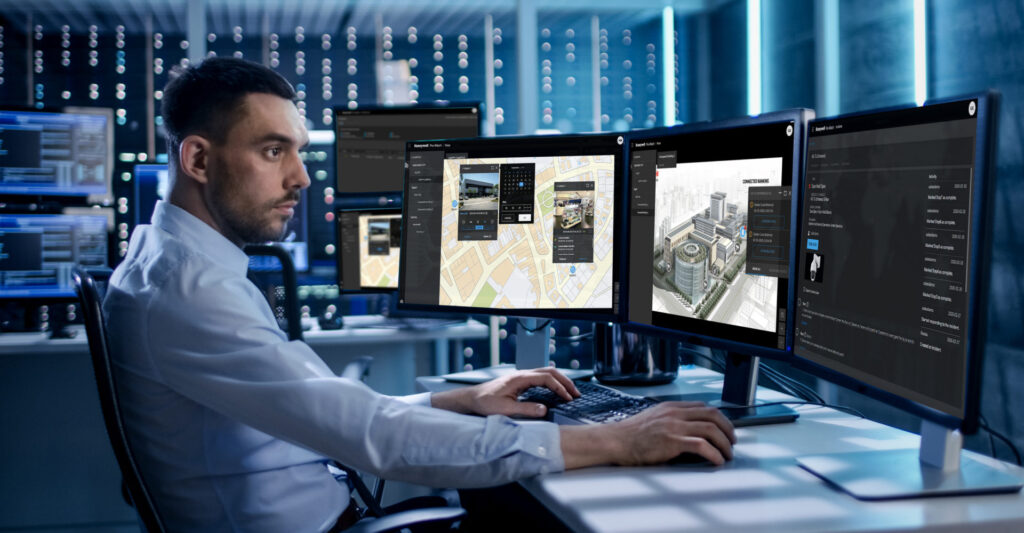Central Monitoring Services – 24/7/365
Why Central Monitoring is so Important
Perhaps one of the biggest benefits of having a monitored security system is that your home or business is being watched at all times even when you cannot do it yourself. Burtel Security & Fire offers 24/7 monitoring, and can track any significant events that occur while you are away and then quickly dispatch the appropriate emergency personnel if necessary. Monitoring provides peace of mind for you, knowing that your valuables are being watched around the clock.
Detector Monitoring:
Burglar – Doors, Windows, Motion Detectors, Water, Glass Break
The most basic alarm consists of one or more sensors to detect intruders, and an alerting device to indicate the intrusion. However, a typical premises security alarm employs the following components:
• Premises control unit (PCU), Alarm Control Panel (ACP), or simply panel: The “brain” of the system, it reads sensor inputs, tracks arm/disarm status, and signals intrusions. In modern system, this is typically one or more computer circuit boards inside a metal enclosure, along with a power supply.
• Sensors: Devices which detect intrusions. Sensors may be placed at the perimeter of the protected area, within it, or both. Sensors can detect intruders by a variety of methods, such as monitoring doors and windows for opening, or by monitoring unoccupied interiors for motions, sound, vibration, or other disturbances.
• Alerting devices: These indicate an alarm condition. Most commonly, these are bells, sirens, and/or flashing lights. Alerting devices serve the dual purposes of warning occupants of intrusion, and potentially scaring off burglars. These devices may also be used to warn occupants of a fire or smoke condition.
• Keypads: Small devices, typically wall-mounted, which function as the human-machine interface to the system. In addition to buttons, keypads typically feature indicator lights, a small multicharacter display, or both etc.
• Interconnections between components. This may consist of direct wiring to the control unit, or wireless links with local power supplies.
Fire
• Sprinkler, Smoke, Pull Stations, Heat, Cold, CO Detection
Medical Alert
Types of devices:
• Temperature sensors
• Water sensors
• There are a number of different devices that can be used to trigger an alarm.
• Pendant worn around the neck
• Small device worn on the belt
• Wristband
• Installed motion detectors in a home
• Radar based detectors in a room
• A smart phone
• Active devices require the user to take some action to trigger an alarm condition; passive systems monitor the user and raise an alarm based on an algorithm – a fall, lack of activity, etc. A weakness of active devices is that the user must be conscious to trigger the alarm. Both passive and active devices require that the user wear the device. Installed systems can be expensive and difficult to deploy.
Functionality:
• Medical alarm device with GSM support
• Personal Device
• a wireless transmitter, which is worn around the neck, on a belt, or on a wrist
• an application running on a smart phone and carried in a pocket
• the device may contain a speaker and microphone
• Sensor(s)
• fall detection sensors
• movement sensors
• door open/close sensors
• usage sensor on a device such as a microwave oven
• Communication
• cellular data access for operation anywhere there is cell phone coverage
• an in-home base station that is either connected to a regular telephone, a WiFi network, a DSL/Broadband line, or to a cellular data network. The base station may contain a speaker and microphone
Data:
• some systems will transmit the GPS location of the alarming device
• some systems can be configured to transmit additional personal information when an alarm is triggered (such as age, medical history, etc)
• Responders
• Class-8 EMT Operators
• local 911 service
• friend(s) or family
• In addition, there are various other types of accessories (emergency buttons, fall sensors, smoke detectors, carbon monoxide detectors, flood detectors, motion detectors) that can be placed around the home and integrated with the base station.
• Many base stations are available that can be connected over analog or digital connections. In the event of a power failure, these devices can operate on batteries, thus adding an extra degree of safety.
• In case of emergency the user can set off a call for help by the press of an alert button on his personal device, without needing to reach the telephone. Systems with passive alerts may set off a call for help if no movement has been detected over some period of time, or if a fa II is detected.
• If a base station shares a phone line, it is able to terminate an inprogress call so that a call for help can be initiated over the telephone.
• With some systems, an alert arrives in the offices of the alert system operator (which may be a public rescue service or a private security company) and the data of the affected person (address, medical condition, family contacts) are displayed. With others, there is no system operator, and the user simply programs the numbers of family members, neighbors, or local emergency responders.
• If present, a responder can speak with the user through the microphone/speaker in order to clarify the type and severity of the emergency and discuss further measures.
• Depending on the organization of the service and the type of emergency help required, relatives or neighbors can be informed. If necessary, health care services or personal physicians can be notified or emergency medical services can be alarmed. Some monitoring services also provide the client with a USB medical alert device so that arriving emergency personnel can have immediate access to vital medical information.
• Some units can call user selected numbers, so relatives or neighbors can be called directly, avoiding the expense of a monitoring service.
• With some systems, it is common practice for the user to leave a house key with a neighbor or at the system office so that emergency personnel can enter the house even if the resident cannot open the door. Keys are kept in a safe and marked only with numbers so that improper use is precluded.
• In addition to this “active alarm” there is also the option of a “passive alarm” (sometimes called a “safety clock”), on the principle of a socalled dead man’s switch. On some device is a button that the user is to activate several times a day; this confirms that the user is well. If this confirmation goes lacking for a longer period (usually around 12 hours), a telephone call is placed or someone is sent to check whether everything is in order at the residence.
• Depending on the company offering it, the system may provide for more than emergency use. Some solutions will periodically call to converse with the user.
Monitoring:
• In the event of an alarm, some systems will place a phone call to a community emergency service such as 911. Others will place a call to the configured number of a friend or family member. Some systems will send an SMS message to configured contacts.[3]
• Some systems provide 24x7x365 professional monitoring. The monitoring service for medical alarms (central station) is a call center facility that is staffed by trained professionals. These professionals are available at all times to receive calls from the medical alarm system. Monitoring service centers that are approved by Underwriters Laboratories (UL) have internal backup systems to add redundancy. Some monitoring services employ trained medical operators enabling them to better evaluate the severity of medical requests. In most less developed countries however, response to medical alarms are slow.
Panic Alarms:
• A panic alarm is an electronic device designed to assist in alerting somebody in emergency situations where a threat to persons or property exists.
• A panic alarm is frequently but not always controlled by a concealed panic alarm button. These buttons can be connected to a monitoring center or locally via a silent alarm or an audible bell/siren. The alarm can be used to request emergency assistance from local security, police or emergency services. Some systems can also activate closed-circuit television to record or assess the event.
• Many panic alarm buttons lock on when pressed, and require a key to reset them.
Notifications
• Phone
• Wireless home security provides protection for your home and family that is not only in your control but accessible from most anywhere, allowing homeowners a connection to their systems and their property that other systems can’t provide. Security email and text alerts allow you to take the access to your home safety and protection to the next level, alerting you on a predetermined schedule, or when there’s an alerted condition you need to know about. Whether you want a photo texted to you when your kids come home from school, or an email notification when the door is opened or the security system has been disarmed, email and text notifications keep you in touch by bringing your home security status to your web-enabled device.





